Chaco Canyon is well off the beaten path. There are no gas stations, no water and no accommodations.
But don’t let that deter you!
I visited Chaco a few weeks ago. It was a camping trip. Now those of you that know me, know that this girl doesn’t camp unless it’s with an RV magically delivered to the site, fully stocked, with clean sheets. Preferably with a nicely stocked wine refrigerator. But, in keeping with my Lessons from the Road, I decided to stretch my comfort zone a bit.
After all, it was only 2 nights and three days.
Surely I could cope with that!
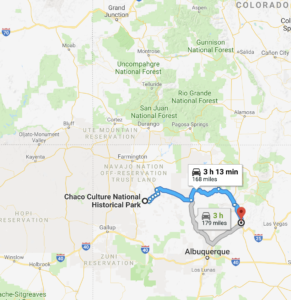
The route from Santa Fe to Chaco Canyon
Click Here To Visit The Photo Gallery!
Chaco is located a little over 3 hours north of Santa Fe. Most of the road is paved, and even the unpaved portions are very drivable. Including the twenty one teeth rattling miles from the highway to the park. Expect washboard, lots of dust and the occasional rock. Welcome to the west!
Chaco interested me primarily because it seemed to continue a theme of ancient peoples and migrations in the American Southwest. Unlike many national parks that are very user friendly, Chaco is very rudimentary. Dirt roads, no shower, no water, camping and not much else.
But what one might miss in amenities, one finds in nature:
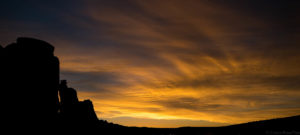
Sunrise at Chaco Canyon
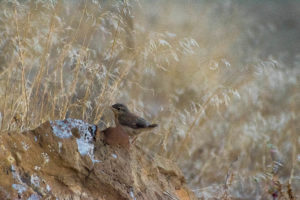
Wildlife in Chaco Canyon
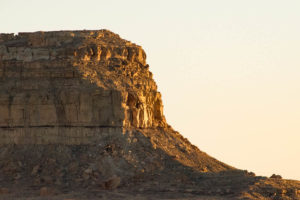
Sunset in Chaco Canyon
But first one must make camp.
I managed to borrow everything I would need. I had a very nice North Face Tent that slept six, just for myself. An inflatable pad, a sleeping bag and a collapsible chair, and I was in business.
Except of course, for putting it all up.
But it all came together in time for dinner and sunset.
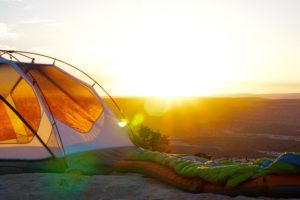
Photo Credit: Jake Sloop
Click Here To Visit The Photo Gallery!
***
Chaco was once the premier civilization in southwest North America. It was built between 850 and 1150, and comprised of numerous villages and buildings connected by perfectly straight roads that ran for hundreds of miles, all leading to Pueblo Bonita. Along the roadways, fires would provide navigation, much as lighthouses did at sea.
The extent of this network and the importance of Chaco as a scientific, cultural and business center cannot be over emphasized.
This was the single largest Anasazi settlement of its day, with five story sandstone and wood buildings and many kivas for spiritual practices.

The area was hunted, farmed and very much alive.
“The Canyon pulsated with life.”
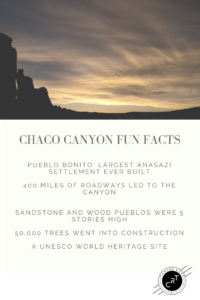
Some facts about the Anasazi settlement at Chaco Canyon
“One hundred years before the first gothic cathedrals were built in Europe, the master architects and stone masons of th Anasazi were building great kivas that could hold 500 people.”
From the National Park Service Website:
For all the wild beauty of Chaco Canyon’s high-desert landscape, its long winters, short growing seasons, and marginal rainfall create an unlikely place for a major center of ancestral Puebloan culture to take root and flourish. Yet this valley was the center of a thriving culture a thousand years ago. The monumental scale of its architecture, the complexity of its community life, the high level of its community social organization, and its far-reaching commerce created a cultural vision unlike any other seen before or since.
The cultural flowering of the Chacoan people began in the mid 800s and lasted more than 300 years. We can see it clearly in the grand scale of the architecture. Using masonry techniques unique for their time, they constructed massive stone buildings (Great Houses) of multiple stories containing hundreds of rooms much larger than any they had previously built. The buildings were planned from the start, in contrast to the usual practiced of adding rooms to existing structures as needed. Constructions on some of these buildings spanned decades and even centuries. Although each is unique, all great houses share architectural features that make them recognizable as Chacoan.
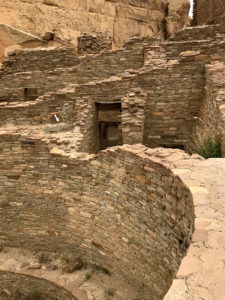
Chacoan architectural remains at Pueblo Bonita
During the middle and late 800s, the great houses of Pueblo Bonito, Una Vida, and Peñasco Blanco were constructed, followed by Hungo Pavi, Chetro Ketl, Pueblo Alto, and others. These structures were often oriented to solar, lunar, and cardinal directions. Lines of sight between the great houses allowed communication. Sophisticated astronomical markers, communication features, water control devices, and formal earthen mounds surrounded them. The buildings were placed within a landscape surrounded by sacred mountains, mesas, and shrines that still have deep spiritual meaning for their descendants.
…Pueblo descendants say that Chaco was a special gathering place where many peoples and clans converged to share their ceremonies, traditions, and knowledge. Chaco is central to the origins of several Navajo clans and ceremonies. Chaco is also an enduring enigma for researchers. Was Chaco the hub of a turquoise-trading network established to acquire macaws, copper bells, shells, and other commodities from distant lands? Did Chaco distribute food and resources to growing populations when the climate failed them? Was Chaco “the center place,” binding a region together by a shared vision? We may never fully understand Chaco.
Entree to the park is via CR 7900 and 7950. Twenty one miles of dirt road, a few Indian houses, and sandy mesas keep the timid at bay. The last four miles are rather rough, particularly near the Escavada Wash, but once one reaches the park the road is paved, if poorly maintained. An eight mile loop through the site provides access to all the major archaeological sites and petroglyphs.
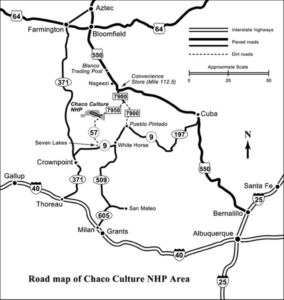
Detail of the route into Chaco Canyon Source: nps.gov
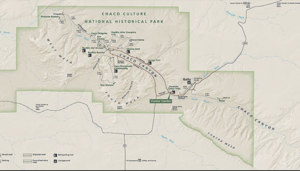
Map detail of Chaco Canyon and the 8 mile loop that provides national park access. Source: nps.gov
There is one campsite, and reservations are recommended. (It would be a shame to drive all the way out here and be unable to stay. And there are no accommodations for many miles. The closest town is about an hour away.) Plan ahead, check any park restrictions (such as no open fires) and roadway access, and bring lots of water. This is the desert and there is no potable water in the rest facilities at the campsite.
Click Here To Visit The Photo Gallery!
Part of the lure of Chaco is its mystery. Why was the Chaco chosen as a location? Why after 300 years did the Anasazi suddenly pack up and leave this hub of spiritual life, science and commerce and move to Mesa Verde, further north in southwestern Colorado?
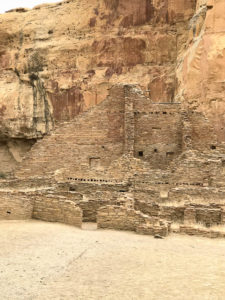
Remains of a multi-story sandstone and timber building at Pueblo Bonito, at Chaco Canyon, a UNESCO World Heritage site
This short video gives some perspective the largest city ever built by the Anasazi:
In it’s prime, Pueblo Bonito and the surrounding communities were vibrant hubs of civilization. It’s been speculated that Chaco Canyon was a celestial center for study; it was certainly a major trading post; it had deep spiritual traditions which no doubt traveled with the Anasazi when they departed.
When the Anasazi left for Mesa Verde, the lineage of the people continued, but Chaco did not. The reasons for the disappearance of the Anasazi are not clear. It may have been weather related: as it was for the Santa Clara Pueblo residents who moved from their cave dwellings, east to the Rio Grande as a result of drought. Or their disappearance may have had other reasons.
We may never know the reasons for the demise of this civilization, but the architecture, religion, and ceremonies of the Anasazi have been passed through to subsequent generations. From the adobe buildings that dominate the region, to the traditional Indian dances celebrated at cultural gatherings like the Gathering of Nations, the Anasazi heritage lives on. This history forms a rich tapestry in northern New Mexico that blends native Indian, Spanish and American cultural elements to create a truly unique place, with a deep sense of place that reaches back hundreds of years.
And as for the camping: It was just fine! Cold at night. Relentlessly hot during the day. And a sand storm.
Welcome to the desert!
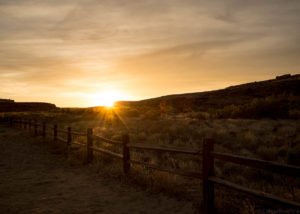
Sunrise at Chaco Canyon
Click Here To Visit The Photo Gallery!
More Resources for Camping at Chaco Canyon
From Amazon:
THE MYSTERY OF CHACO CANYON examines the deep enigmas presented by the massive prehistoric remains found in Chaco Canyon in northwestern New Mexico. It is the summation of 20 years of research. The film reveals that between 850 and 1150 AD, the Chacoan people designed and constructed massive ceremonial buildings in a complex celestial pattern throughout a vast desert region. Aerial and time lapse footage, computer modeling, and interviews with scholars show how the Chacoan culture designed, oriented and located its major buildings in relationship to the sun and moon. Pueblo Indians, descendants of the Chacoan people, regard Chaco as a place where their ancestors lived in a sacred past. Pueblo leaders speak of the significance of Chaco to the Pueblo world today.
The film challenges the notion that Chaco Canyon was primarily a trade and redistribution center. Rather it argues that it was a center of astronomy and cosmology and that a primary purpose for the construction of the elaborate Chacoan buildings and certain roads was to express astronomical interests and to be integral parts of a celestial patterning.
While the Chacoans left no written text to help us to understand their culture, their thoughts are preserved in the language of their architecture, roads and light markings. Landscape, directions, sun and moon, and movement of shadow and light were the materials used by the Chacoan architects and builders to express their knowledge of an order in the universe.
Chaco Canyon in northwestern New Mexico contains a remarkable set of Ancestral Puebloan buildings. Occupied between AD 850 and 1150, Chaco appears to have been the cultural and political center for much of what is now the Four Corners region. Many sites in the Chaco Culture National Historical Park have been continuously studied for more than a century. Vivian and Hilpert wrote this encyclopedic handbook to help organize the extensive amount of information available for Chaco, as well as to stimulate speculation and encourage further exploration. The result is a highly accessible but thorough reference.
The Chaco Handbook includes more than 270 cross-referenced, alphabetical entries, more than 100 illustrations and maps, plus histories of Chaco’s development and ensuing archaeological research. Entries address important Chacoan and related sites, place-names, archaeological and ethnographic terms, objects and architectural features, and institutions and individuals. This second edition includes a new preface, a new chapter on professional explanations for the “Chaco Phenomena,” additional entries, and revisions to existing entries. Useful to anyone with an interest in the Ancestral Puebloans, including specialists, this handbook will guide readers to greater exploration of Chacoan culture and the Chaco world.
From Amazon:
The Anasazi of Chaco Canyon by Kyle Widner.
Perhaps the most fascinating chapter in Southwest history is the tale of the mysterious, “vanished” Anasazi Indians. Their tremendous achievements can be found in many places, including the spectacular cliff dwellings of Mesa Verde National Park. But the crest of the Anasazi wave was in Chaco Canyon, a shallow, windswept wash in northwest New Mexico. Here in Chaco Canyon, 1,000 years ago, strange and unexplained events unfolded; events which continue to intrigue scientists, visitors, and those interested in the Anasazi.
During the years 850-1150 AD, the Anasazi built multi-story buildings comparable in size to the Roman Coliseum in Chaco Canyon. Advanced astronomy, water works, and agriculture flourished. Exotic artifacts from Central America were traded over routes spanning thousands of miles. And after 300 years, the Anasazi carefully sealed everything up, left Chaco Canyon, and never returned.
The Anasazi of Chaco Canyon offers insight into the unknowns of the “Chaco Phenomenon”. In addition, it draws on the latest Anasazi research, personal experiences, and interpretations of oral traditions, leading the reader to a startling conclusion. What happened in Chaco Canyon? Why did the Anasazi choose this foreboding location to construct spectacular Great Houses?
More Posts on the Rich Heritage of the American Southwest:
Santa Clara Pueblo: Cliffs, Pottery and Art
Puye Cliff Dwellings: Earth, Spirit, Fire and Art
Photo Mission:Winter at Taos Pueblo
Ojo Caliente, Wind Chimes,and Water
Ojo Caliente Encore!
Like This Post? Pin It!
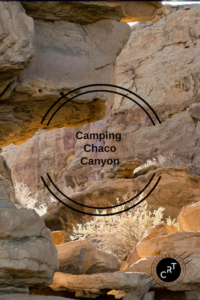
If you’re interested in learning more about photography (or cooking or film or any number of topics) check out MasterClass All-Access Pass for on-line excellence.
[et_bloom_inline optin_id=”optin_10″]
What is #CancerRoadTrip and how did it come to be? Read this post to get the backstory!
Follow me on Twitter, Pinterest, Instagram, and at Anti-Cancer Club. Connect with me! I may need a place or two to stay along the way!

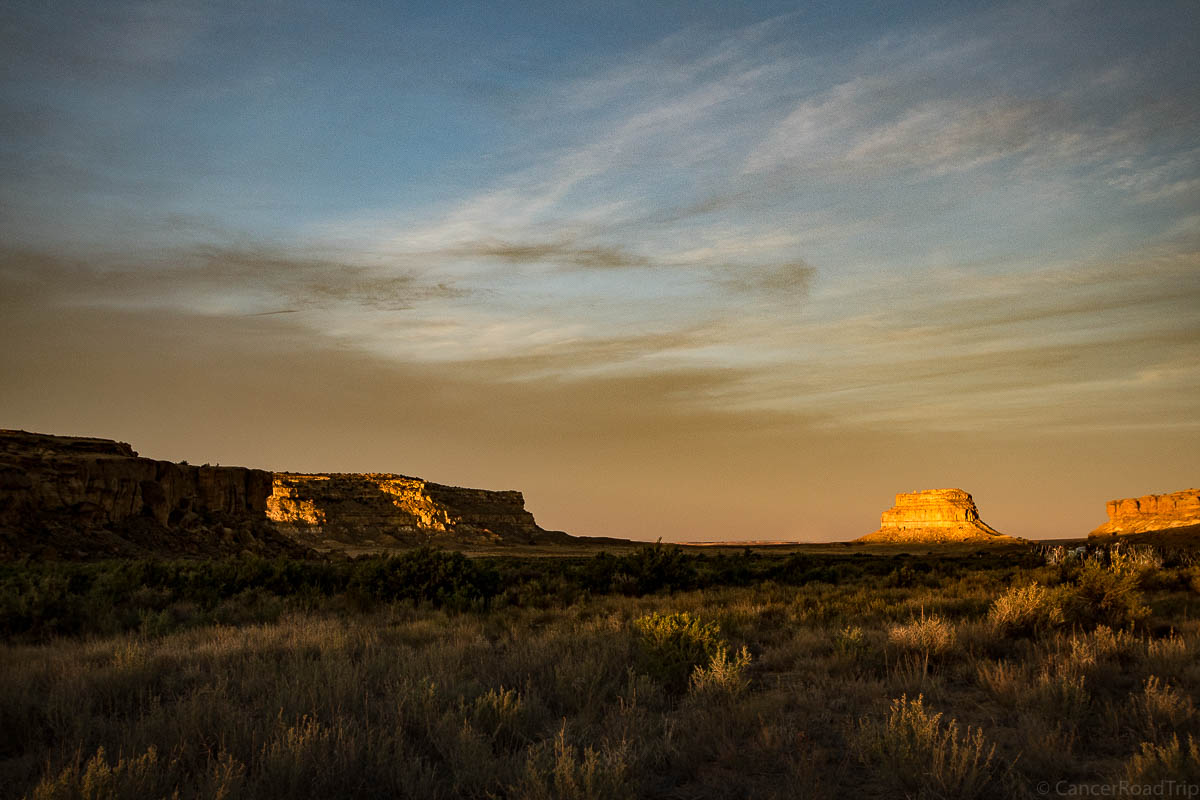




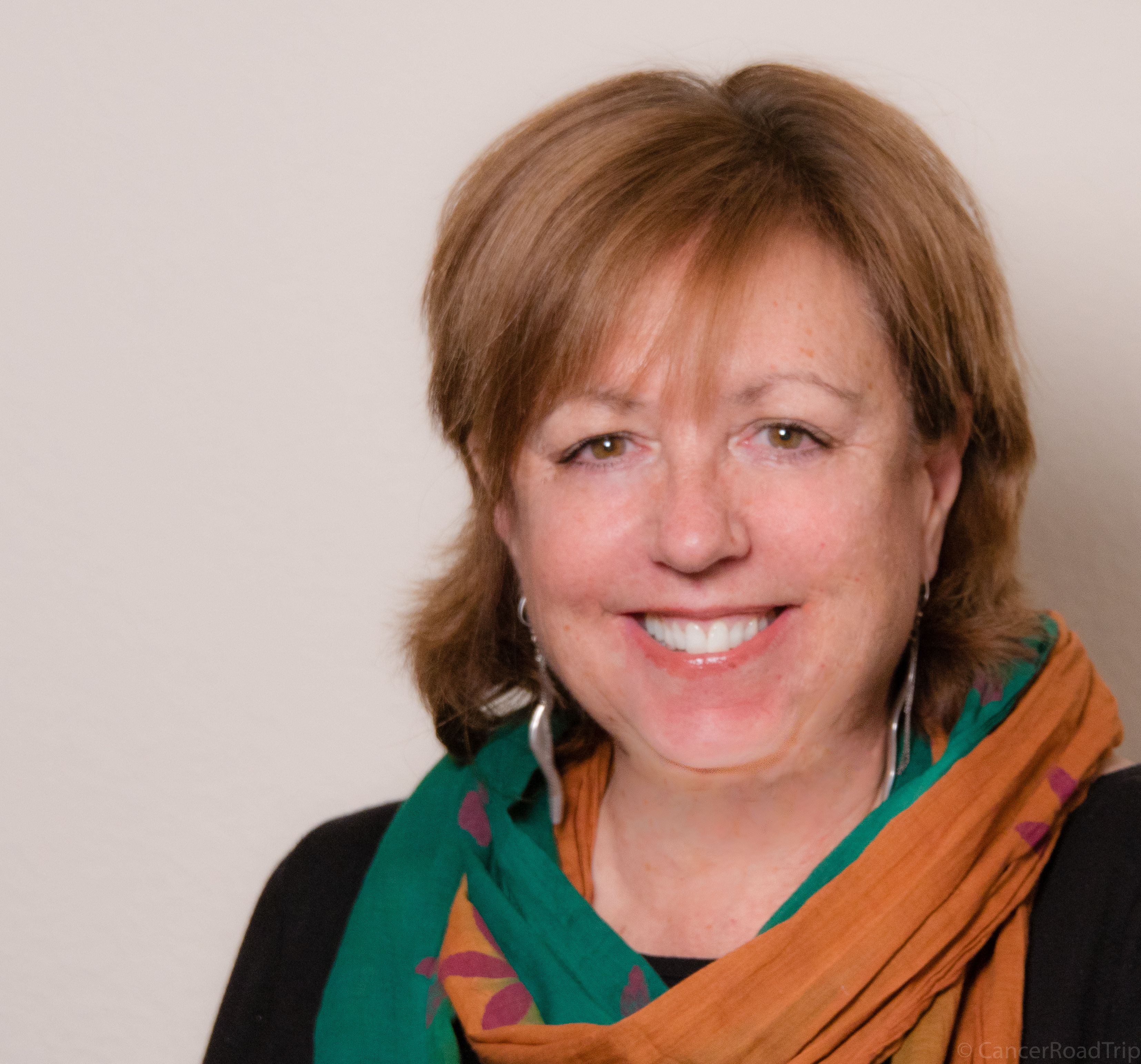
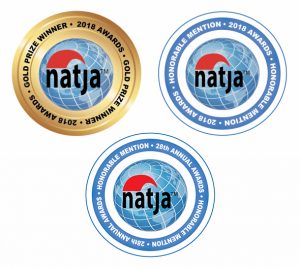





We just learned about Chaco Canyon a few days ago so it was great to find this. Hoping to go later this fall. Love the pictures!